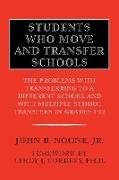- Start
- Students Who Move and Transfer Schools
Students Who Move and Transfer Schools
Angebote / Angebote:
Transferring Schools - Grades 1 - 12 (And The Problem With Attending Different High Schools): This book, written by a person who attended nine different schools in twelve years including four different High Schools in four years, is intended to ease the transition process for students who transfer schools. The unique problems students might encounter in transferring between elementary, Junior High, and High Schools are discussed and recommended solutions are given. The book is designed to be a quick and easy read and long term reference guide for parents (or guardians), teenagers, teachers, and administrators in all private, public, and parochial schools throughout the United States and at American schools overseas. Throughout the book, the author describes his own experiences and memories, as well as the special problems he discovered while transferring schools. The book begins by discussing the hidden effects on children and on the parent (or guardian) when there is a transfer between schools. Although transferring between schools is a part of life and has been as ongoing as long as American schools have been in existence, very little, if any, attention has been given over the years to easing the difficulties students face after leaving a school and to recognizing and understanding the problems those students encounter upon arrival at a new school. Therefore, the author believes that transferring schools should be avoided if possible, but recognizes that often a transfer between schools is necessary. Regardless of whether a transfer can be avoided, parents (or guardians) are advised to carefully consider their child when a decision is made to transfer schools. In this book, parents (or guardians) are asked to try as best possible to view objectively the stage of development of their child who is to transfer schools. The transfer to a different school will result in at least some adjustment (or disruption) to the child, and any negative effects of the change will eventually be a concern to the parent (or guardian). The two types of transfers (either at the beginning of the academic year or during the academic school year) are discussed. Then, the difference between transferring schools when a school has been in existence for a number of years or when a new school that has just been opened is analyzed. Transferring schools in different grades can create different problems for the student and so the various aspects of life for the transfer student in elementary school, middle (or Junior High) School, and High School are brought to the attention of the reader. An emphasis is placed on High School because academic performance during those three or four years largely determines what college a student can attend or what type of job a person can obtain upon entering the workforce. When a teenager transfers to different High Schools, the person enters into a different environment from the school previously attended. But there are differences when the transfer occurs at the High School level as compared to earlier years in school, which the author describes through his experiences in the four High Schools he attended. As he recounts, each High School was a different school, but very similar social circumstances occurred and personality types were encountered at the four High Schools he attended. The author concluded that transferring to a different High School or many different schools between grades nine through twelve will likely be an unpleasant experience. As stated in the book, in High School, the personality and academic development for the student who transfers will likely take longer unless favorable circumstances are present in the new High School to reduce the time for the adjustment process to be completed. Thus, the author believes that by having attended
Folgt in ca. 10 Arbeitstagen


